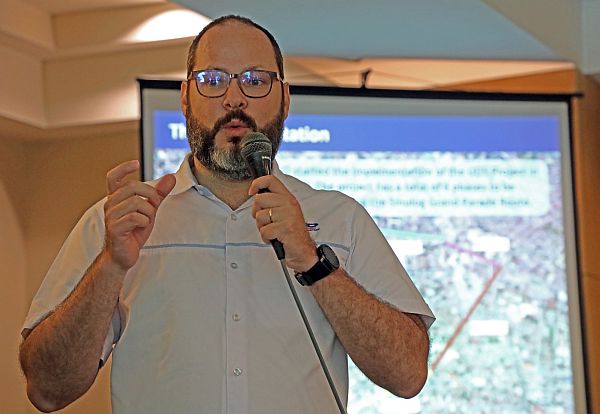
Anton Perdices, chief operating officer of Visayan Electric Co. (Veco), updates Cebu media on the underground distribution system project implemented on major Cebu City streets during Tuesday’s 25th Cebu Press Freedom Week Power lunch at Cebu Sports Club.
CDN PHOTO/TONEE DESPOJO
Veco eyes citywide expansion of underground distribution system project
The Visayan Electric Company (Veco) is considering eventually expanding its underground distribution system (UDS) to the rest of Cebu City once it completes the project along the Sinulog Grand Parade route.
Spanning 4.75 kilometers and consisting of six phases, the distribution company has already completed phases 1A and 1B and recently began work on phase two last Sept. 15.
“Eventually, we would like to (do it citywide), especially in areas with a lot of trees since those are the ones that become hazardous during typhoons,” Veco Chief Operating Officer Anton Mari Perdices said during the “Power Lunch” with local media on Tuesday.
The underground cabling project is the power distributor’s answer to Cebu City Ordinance No. 1894, approved on April 25, 2001, which seeks to get rid of unsightly wires along city roads.
Phase 1A, a 650-meter underground cabling project from the Cebu Provincial Capitol to Fuente Osmeña Circle, cost P96 million and was completed in 2015.
Meanwhile, phase 1B, a P65.5-million underground cabling spanning 1,100 meters from Fuente Osmeña Circle to the corner of P. del Rosario Street, was completed in March this year.
Veco has earmarked more than P50 million for phase 2, which covers 600 meters from the corner of P. del Rosario Street and Osmeña Boulevard to the corner of Sikatuna Street.
This phase of the project is expected to be completed by February 2018.
Veco targets to finish the remaining four phases in four years, with one phase launched every year.
The company is also looking for ways to further reduce the costs for the project as it progresses, said Perdices.
After the Sinulog parade route, Perdices said, they could possibly work on the Banilad-Talamban corridor.
“The problem there is that the sidewalks are so narrow and the drainage is right underneath. We need to look for the best solutions,” he said.
The Veco official said he would be willing to sit down with the Cebu City government to discuss what to do next after the current UDS project would be completed in four years.
Aside from the BanTal corridor, Veco officials are also considering bringing the UDS to the South Road Properties.
Unless they are mandated to do so, Perdices said they are not keen on bringing the UDS to the rest of Veco’s franchise area which spans 675 kilometers.
“If we do one kilometer every year, that’s more than 600 years,” he said.
Veco’s franchise area includes the city of Cebu, Mandaue, Talisay and Naga, as well as the municipalities in the greater part of Metro Cebu such as Liloan, Consolacion, Minglanilla and San Fernando.
Engineer John Brylle Sanchez of Veco’s power systems design department said the UDS is necessary for aesthetics, safety, more stable power and avoiding pole-related problems.
“With the UDS, we will have more stable and reliable electricity,” he said.
Aside from getting rid of tangled wires along the road, placing power lines underground will also keep them safe from typhoons or lightning strikes, thereby reducing power interruptions within Veco’s franchise area.
Asked about flooding concerns, Engineer Armil Logarta, manager of the Veco power systems design department, said they use Piranha waterproof connectors to keep their lines flood-proof.
“Even if there’s a flood, our power will still be there,” he said.
As of July this year, the power distributor has 416,000 customers within its franchise area.